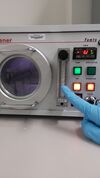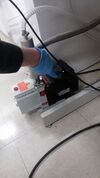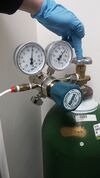McClean: Flow Cells
Overview
This protocol covers the soft lithography and plasma bonding steps used to make flow cells out of PDMS in our lab. This protocol assumes that you are starting with a silicon wafer mold that already has your desired pattern on it. We make out own SU8 molds in the Princeton Microfluidics Laboratory.
Materials
- Slygard 184 Silicon Elastromer (Ellsworth Adhesives)
- 4” petri dishes (for storing chips)
- Small ~6” pieces of the intramedic tubing (ID 0.86mm OD 1.27mm)
- Razor blades
- Biopsy Punches (1.2mm, 1.0mm, 0.75mm diameters) (
- Nitrile gloves
- Stainless steel blunt needle, 16 ½” gauge
- Small green needle (21 ½ gauge Becton-Dickinson)
- Scotch tape
- 1ml syringes with Luer-Lok tips
- 1.5mm Coverslips
- Oven set to 65°C
- TMCS (chlorotrimethyl silane)
- plastic forks for mixing PDMS
- plastic beakers for mixing PDMS
- Vacumn jar for degassing PDMS
Protocol
Wear nitrile gloves, as oils from your hands can prevent the PDMS from curing and/or bonding properly. Please try to not drip PDMS everywhere. It is extremely hard to clean up. Don't get uncured PDMS onto cured chips, as this will prevent the chips from properly bonding to the glass coverslip. In practive this means you should use one pair of gloves for mixing the PDMS and another, clean pair for cutting out the chips and bonding them to the coverslip.
Mixing PDMS to fill the mold
- Mix PDMS in a 1:9 ratio (by weight) curing agent to polymer in a plastic solo cup. The easiest way to do this is by weighing out the polymer first in the plastic solo cup on a balance and then adding the appropriate amount of curing agent
- For these molds you will need ~60 g of total solution the first time you fill up the petri dish (assuming a 4" dish).
- Mix the PDMS THOROUGHLY using a plastic fork. When you think that you’ve mixed it enough, mix it some more. Uneven mixing will lead to uneven curing of the PDMS.
Degassing the PDMS
- Place your PDMS in the vacumn bell jar in the hood and turn on the vacumn. Please wait for your classmates because you will all need to be degassing PDMS at the same time.
- Watch the PDMS degassing. If it looks like it is about to bubble over, release the vacumn, let the bubbles collapse, and then restart the vacumn. Keep an eye on it for at least 10 minutes.
- Make sure that your PDMS is completely free of bubbles. The total degassing process will probably take 15 minutes. While you are waiting you may move on to testing the chips you made previously.
Pour the PDMS
- Pour the PDMS carefully into your mold, trying hard not to introduce bubbles that you have worked so hard to eliminate.
- If you do introduce bubbles carefully use a 21G 1 1/2 gauge needle to move them to the side.
Curing the PDMS
- Cure the PDMS at 65°C until it is firm and not tacky at all. This will probably take an hour. You can also do this overnight if you are running out of time.
Cutting out the Chip
- Using a razor blade, carefully cut around the mask components visible through the PDMS. DO NOT CUT YOURSELF. DO NOT under ANY circumstances push down on the underlying silicon wafer. This will crack the wafer rendering it useless for classmates and for future chip making. It is expensive to replace these molds, so BE GENTLE!!! The best way to cut out the PDMS is to gently circle, removing slightly more PDMS each time. When you see an air bubble form under the PDMS you are getting close, but DO NOT rush at this point. Carefully keep circling the groove until the chunk of PDMS pops-out.
- Cut the large piece of PDMS into individual chips. You want each chip to fit onto your coverslip. Don't cut your chip too small, as this will give it less surface area with which to bond to the coverslip. When you have cut out your chip, cover the channel side with scotch tape.
Punch inlet and outlet ports in your chip
Blunt Needle Technique
Place a piece of scrap PDMS flat on your bench and push a blunt needle through the PDMS. Then use a smaller 21 G 1 ½ needle (pointed) to remove the plug of PDMS from the end of the blunt needle before pulling the blunt needle back through the PDMS to leave a port.
Biopsy Punch Technique
Put a piece of scrap PDMS flat on your bench and use a biopsy punch to push through the PDMS. Be very careful to punch strain down and please don’t bend the tip of the biopsy punch (this renders them basically useless). Eject the plug of PDMS before pulling the biopsy punch back through the PDMS to leave a hole.
- The red, 1.20 micrometer diameter biopsy punch works well for making holes that 24AWG tubing can fit snuggly into.
Plasma bonding the PDMS chip to the coverslip
- Go to the communal lab on the second floor, 2005 of the engineering centers building. Bring scotch tape, 12-544-G 22X60-1.5 microscope cover glass, and your PDMS chip(s) with you.
- Clean the channel side of the chip using scotch tape. Press and remove scotch tape 3X’s from the channel side of the chip.
- Open the glass door of the plasma chamber and remove the long flat layer of glass inside.
- Place your chip (tape free) and a microscope cover glass on the layer of glass. Make sure that the PDMS chip is channel-side up. The sides of the PDMS and glass which are exposed to the air are the parts that will stick to each other. File:Bhattacharya2005.pdf explains the chemistry.
- Put the layer of glass with your PDMS chip and coverslip back into the plasma chamber. Close the door tightly (may require a strong squeeze!).
- Press the red power switch, then press the green "Pump" button (it should light up, if it does not light up, the glass door is not closed tightly enough). If the vacuum pump does not immediately turn ON too, turn it ON.
- Send oxygen from the tank on your right to the plasma chamber.
- On the Plasma Chamber, press the yellow "Gas" button to let air flow from the oxygen tank to the chamber.
- Adjust the black knob until the small black floating ball hovers near 7 in the vertical tube (where my finger is pointing).
- Wait about 20 seconds for the vacuum to suck out air and for the oxygen to fill the chamber.
- Use the double arrows to set the pump to stay on for 0.2 minutes (12 seconds). Press the "Generator" button. You should see a whitish-purple plasma.
- After it has finished, turn off the "Gas" and the "Pump". Turn on the "Ventilation", then pull the door open (may require a good pull).
- Shut both valves on the oxygen tank.
- Remove the chip and glass coverslip, and put the PDMS channel-side down on the glass (onto the side of the glass that was facing up). You should see the PDMS bond to the glass.
- For extra bonding, bake the chip in the oven at 65°C for a few hours or overnight.
Notes
Please feel free to post comments, questions, or improvements to this protocol. Happy to have your input!
- List troubleshooting tips here.
- You can also link to FAQs/tips provided by other sources such as the manufacturer or other websites.
- Anecdotal observations that might be of use to others can also be posted here.
- Megan N McClean 18:42, 13 August 2012 (EDT) Running the plasma for longer will NOT give you better bonding. The surface of the PDMS will become glassy and no longer stick to the glass. Don't got much over 5 seconds for plasma cleaning your chip.
Please sign your name to your note by adding '''*~~~~''': to the beginning of your tip.
References
Contact
- Megan N McClean 14:01, 20 July 2011 (EDT)
or instead, discuss this protocol.


